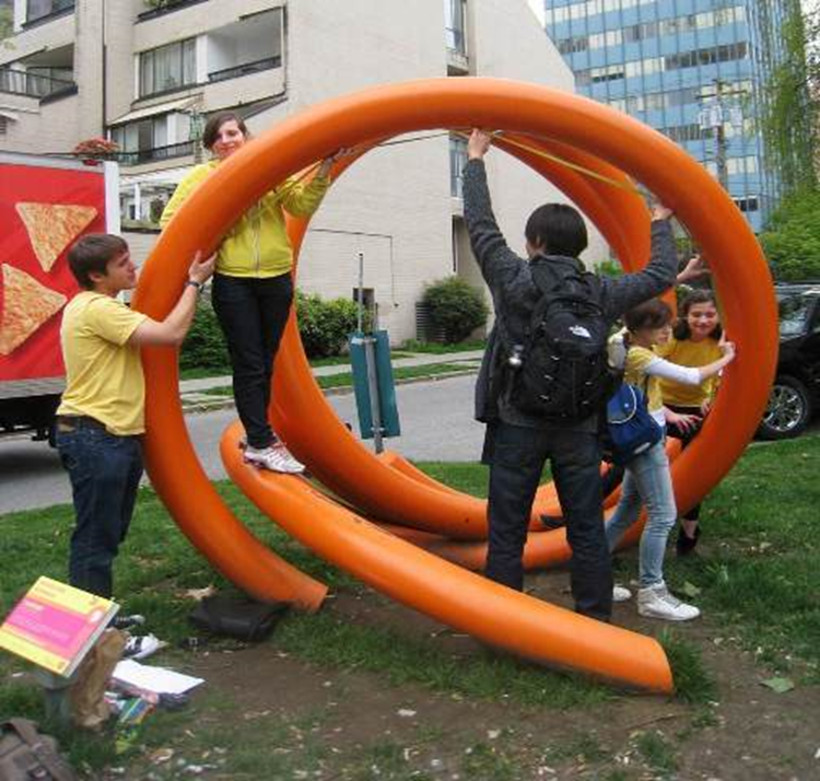Jasper
Mathematics
Sculpture Title:
Learning Lens:
Approaches to Learning
Curriculum Access:
Mathematics
BIG IDEA:
Measurement and Calculation
Guiding Question:
How are materials and product related?
Strategies and Approaches:
Collaboration; measurement; estimation; formulas; assessment of information collection method; how to collect data, where to get data from.
Background for Students:
In this piece the artist uses materials to create different shapes and forms. Referencing the artist’s work, math teachers have created curriculum challenges that incorporate art. Learn More.
Materials:
Measuring tapes, calculator, paper, pencils
Curricular Challenge:
15-20 mins, Open/Reflect: Welcoming Multiple Interpretations
- Students are encouraged to disengage from their recent experience and their busy surroundings to practice mindfulness.
- Direct students to ‘mindfully’ (quietly/individually) explore the piece and develop their own interpretation. More information on mindfulness for the classroom can be found here.
- Direct each student to share their interpretation of the piece without judgement.
- Connect students’ individual interpretations to the background information provided above.
35 mins, Two Part Activity Mathematizing Art
Part I – Math Problem Calculation
Direct groups to complete the following measurements:
- Choose the best place to measure the diameter of a cylinder that makes up the sculpture. Why did you choose to get it from there? Diameter:_____
- If you had a cylinder with the height of 1cm and the above diameter what would the volume be?
- There are two joints that connect the three pieces of the sculpture. Find the length and record for each piece as: piece 1, piece 2 and piece 3.
- What is the total length of the sculpture?
- Use the information from Step 2 and Step 4 to find the volume of the sculpture.
- Review answers utilizing answer key listed below.
Part II – Interviewing the Public on Robson St.
Find a different person to answer each of the following questions correctly (when applicable). Answer key listed below. Debrief what they have learned when completed.
1. Name a famous mathematician.
2. What’s the Pythagorean theorem?
3. What’s -4-2?
4. What’s 1/3+1/2?
5. What do you remember most from high school math?
6. Who was your best math teacher and why?
7. What is radius?
8. What’s the probability of picking a king from a deck of cards (52 cards)?
9. Who was the worst math teacher you had and why?
10. Count backwards by seven starting at 50.
Answer Key:
Part I – Math Problem Calculation
1. Best place to measure diameter is at a cylinder end that is ‘cut’ perpendicularly and not at an angle. We measured a diameter of 22.5 cm or radius of 22.5 / 2 = 11.25cm
2. Volume = (Area of base) x height = (Area of circle) x height = (π x radius2) x height = (3.14 x 11.252)x 1 = 3.14 x 126.6 x 1 = 397 cm3
3. From smallest piece to largest piece (our numbers are estimates , as will be the students’)
Piece 1= 299 cm Piece 2 = 730 cm Piece 3 = 1649 cm
4. 2678 cm
5. 2678 x 397 = 1063166 cm3 = 1.06 m3
Part II – Interviewing the Public on Robson St.
1. Archimedes, Pythagoras, Euler, Gauss, Newton, Pascal, Hilbert, Klein, Ramanujan, Euclid, Leibniz, Fermat, Descartes, Fibonacci, Cantor, etc
2. a2 + b2 = c2 OR if you build a square on each of the sides of a right triangle, the sum of the smaller two squares will equal the largest square
3. -6
4. 5/6
5. Answers may vary
6. Answers may vary
7. Half the diameter OR half way across a circle OR distance from the centre of a circle to the outside
8. 4/52
9. Answers may vary
10. 50, 43, 36, 29, 22, 15, 8, 1
